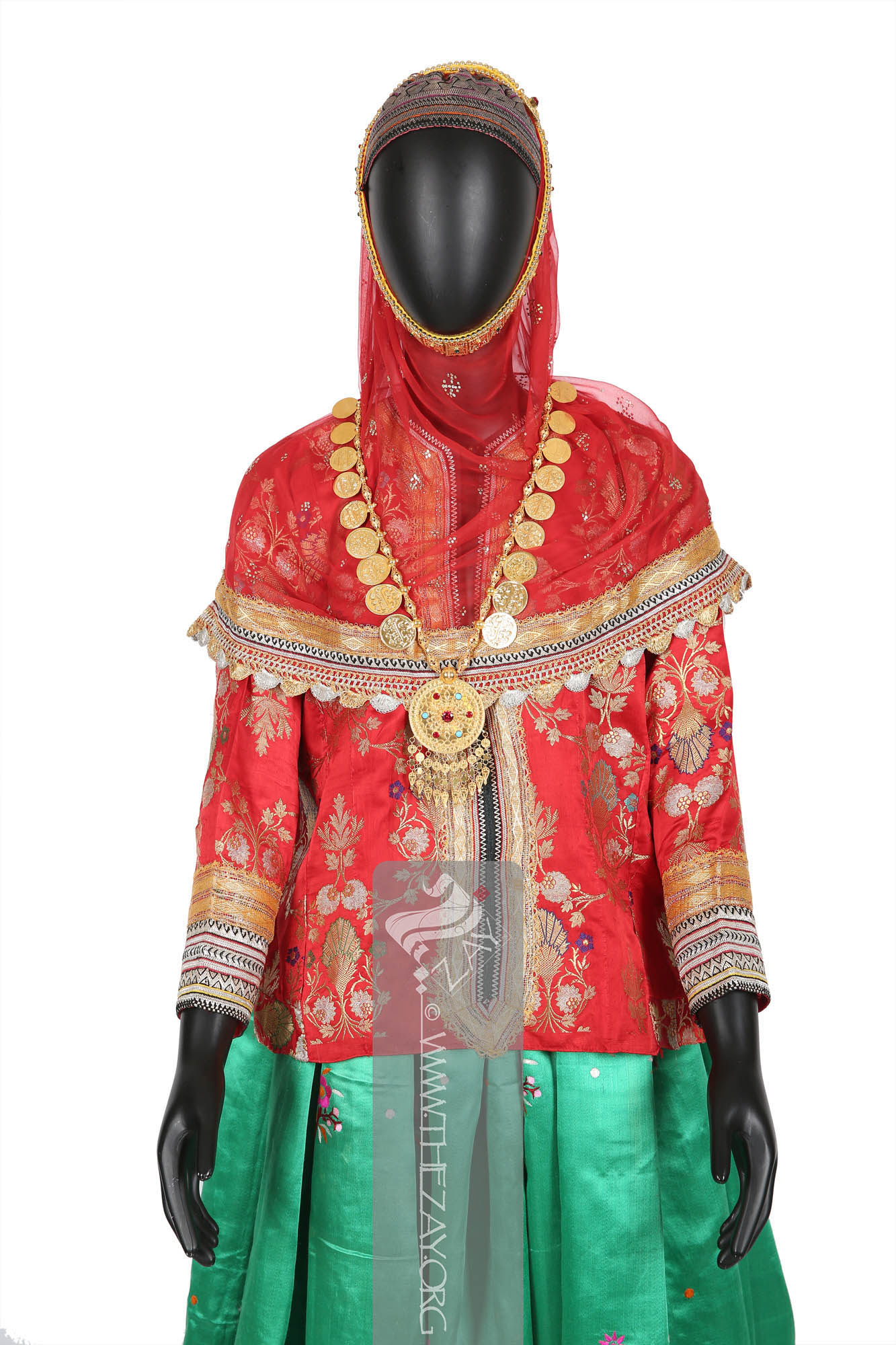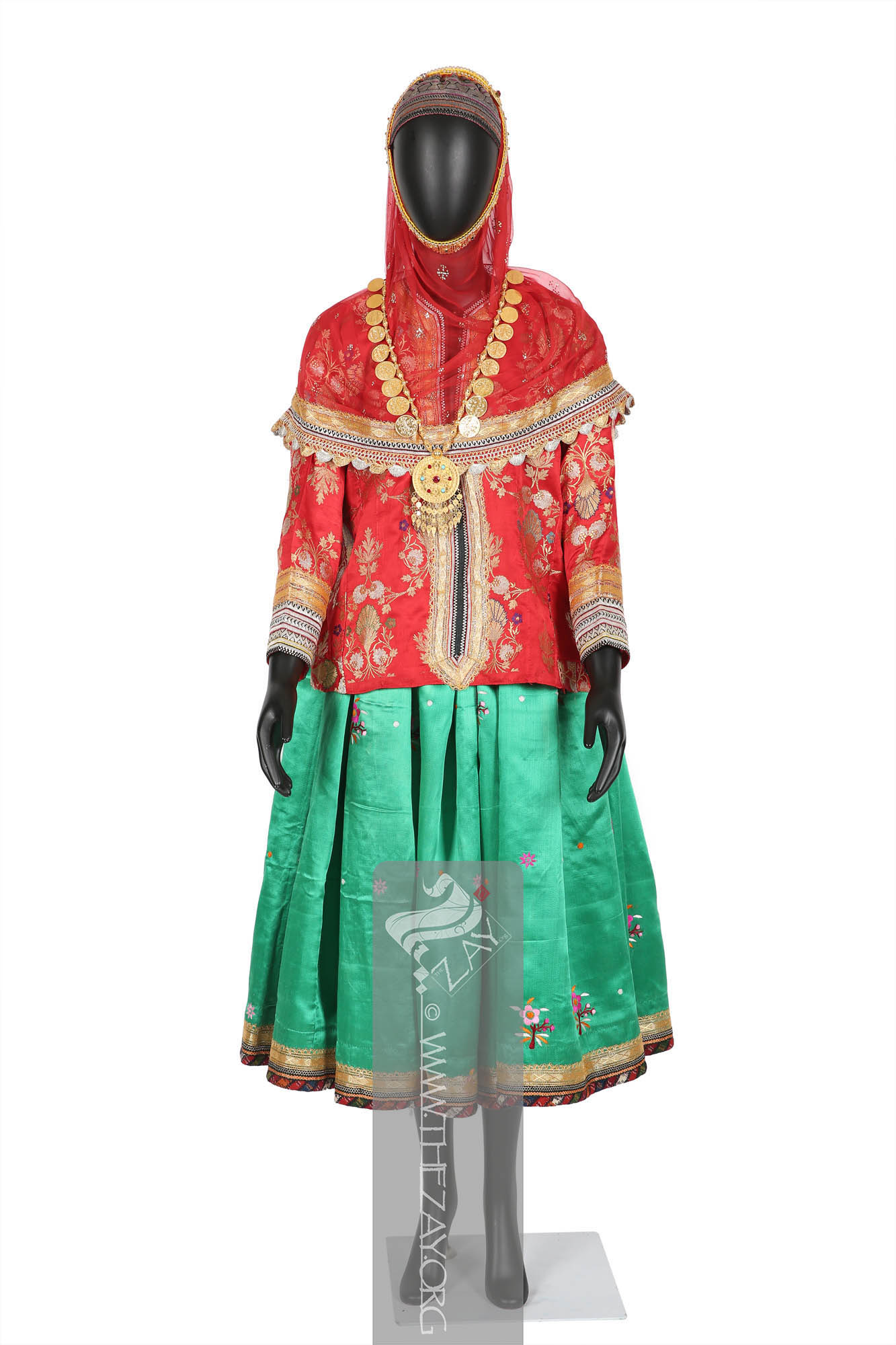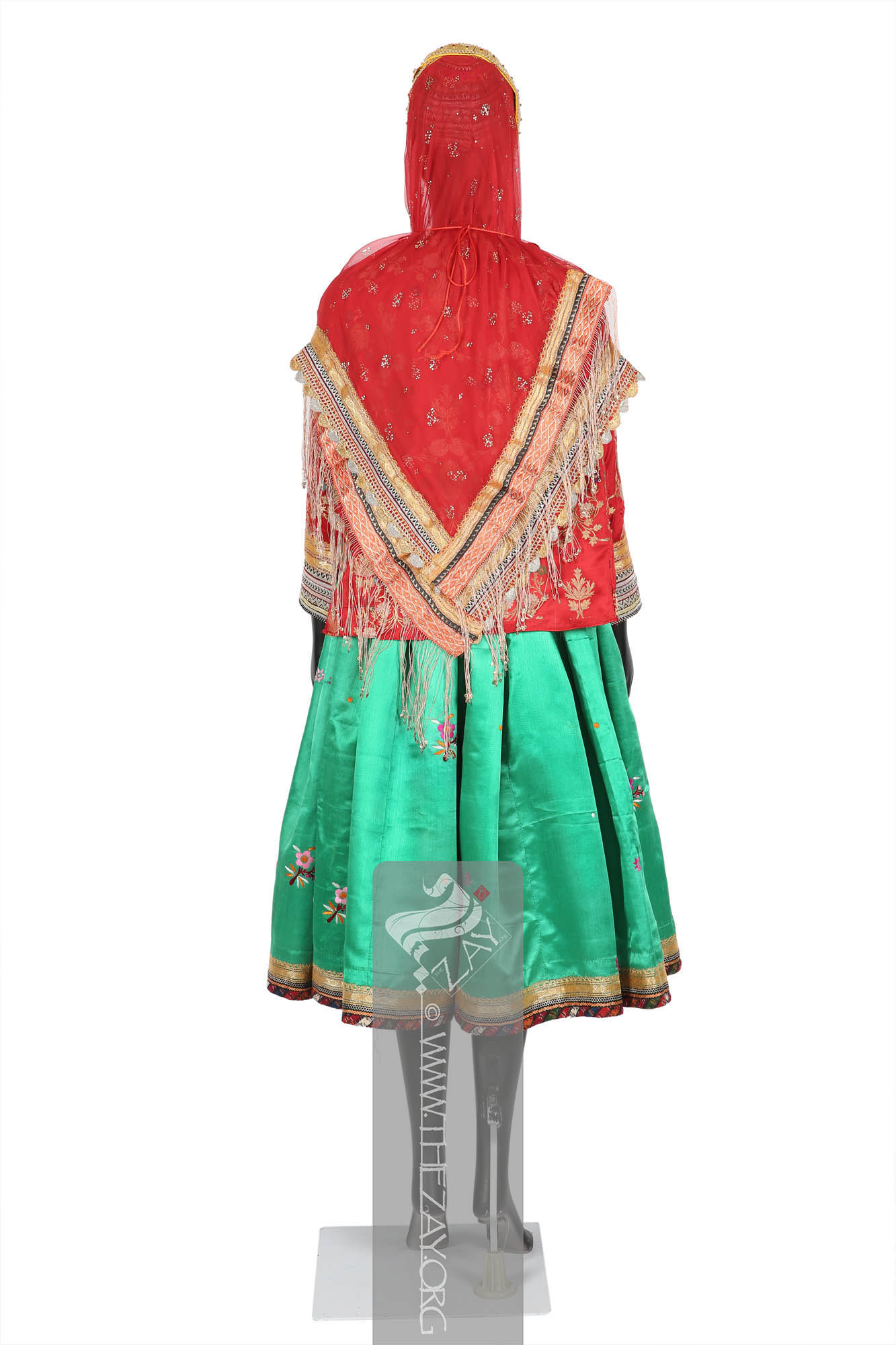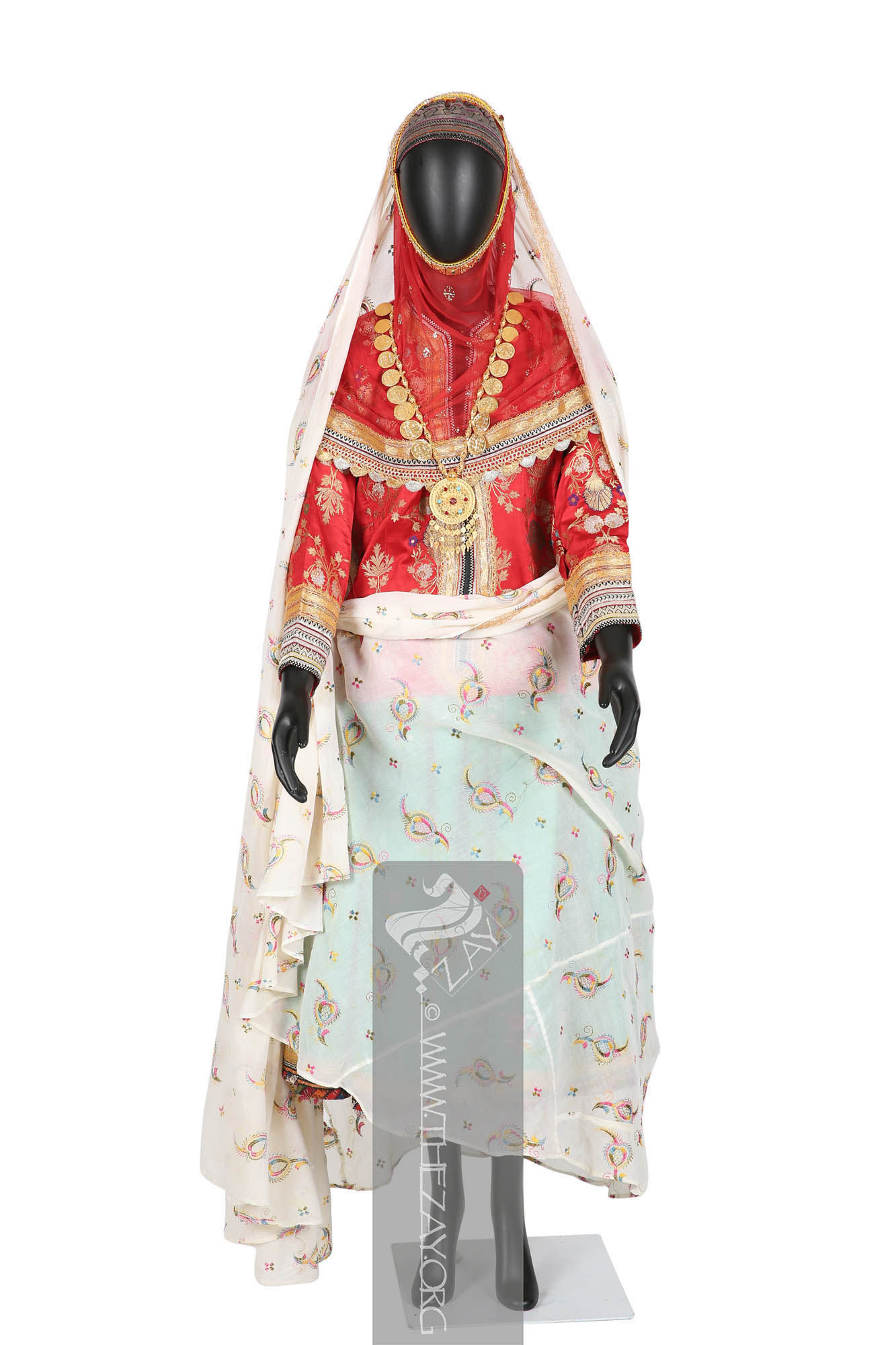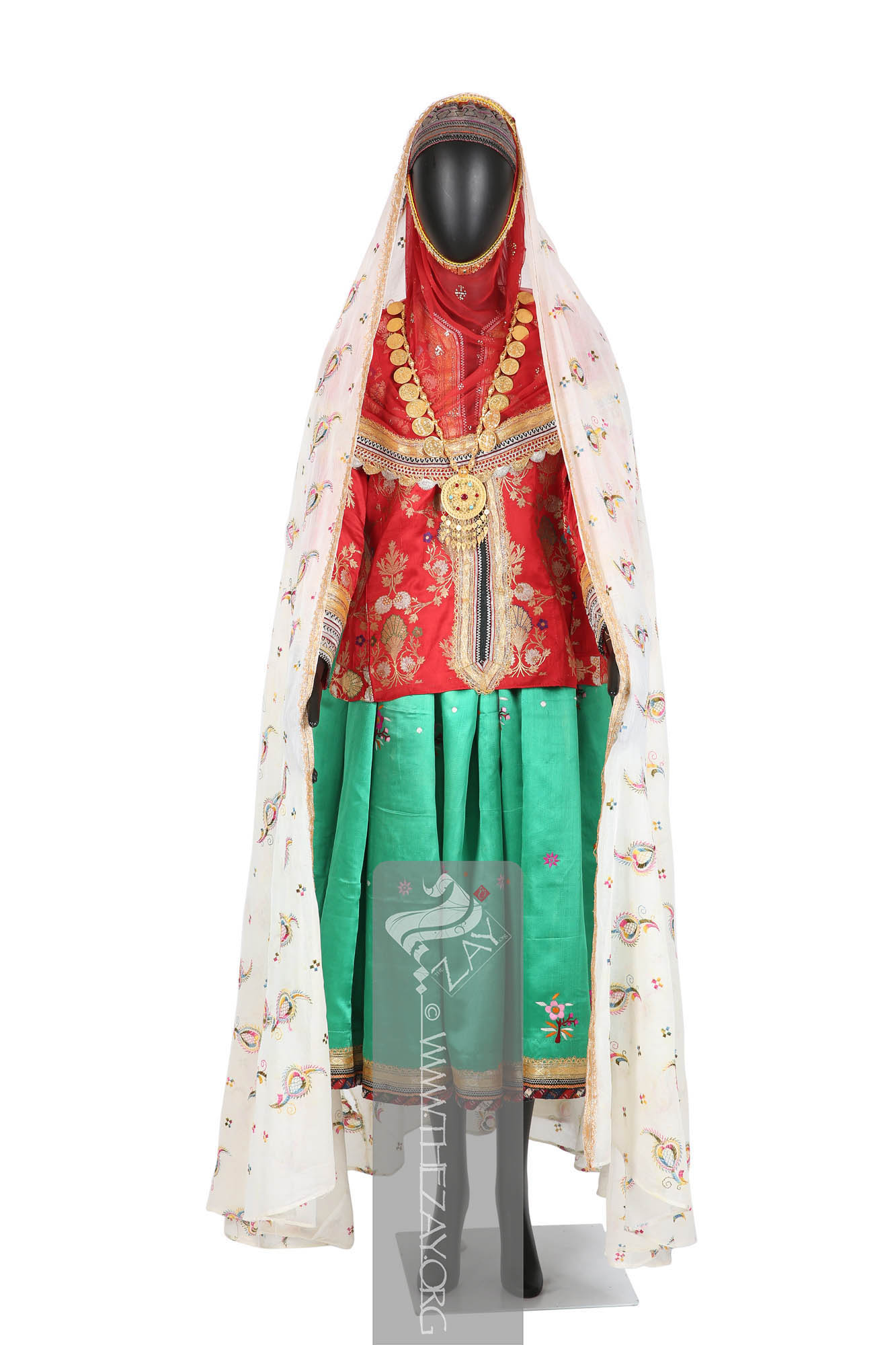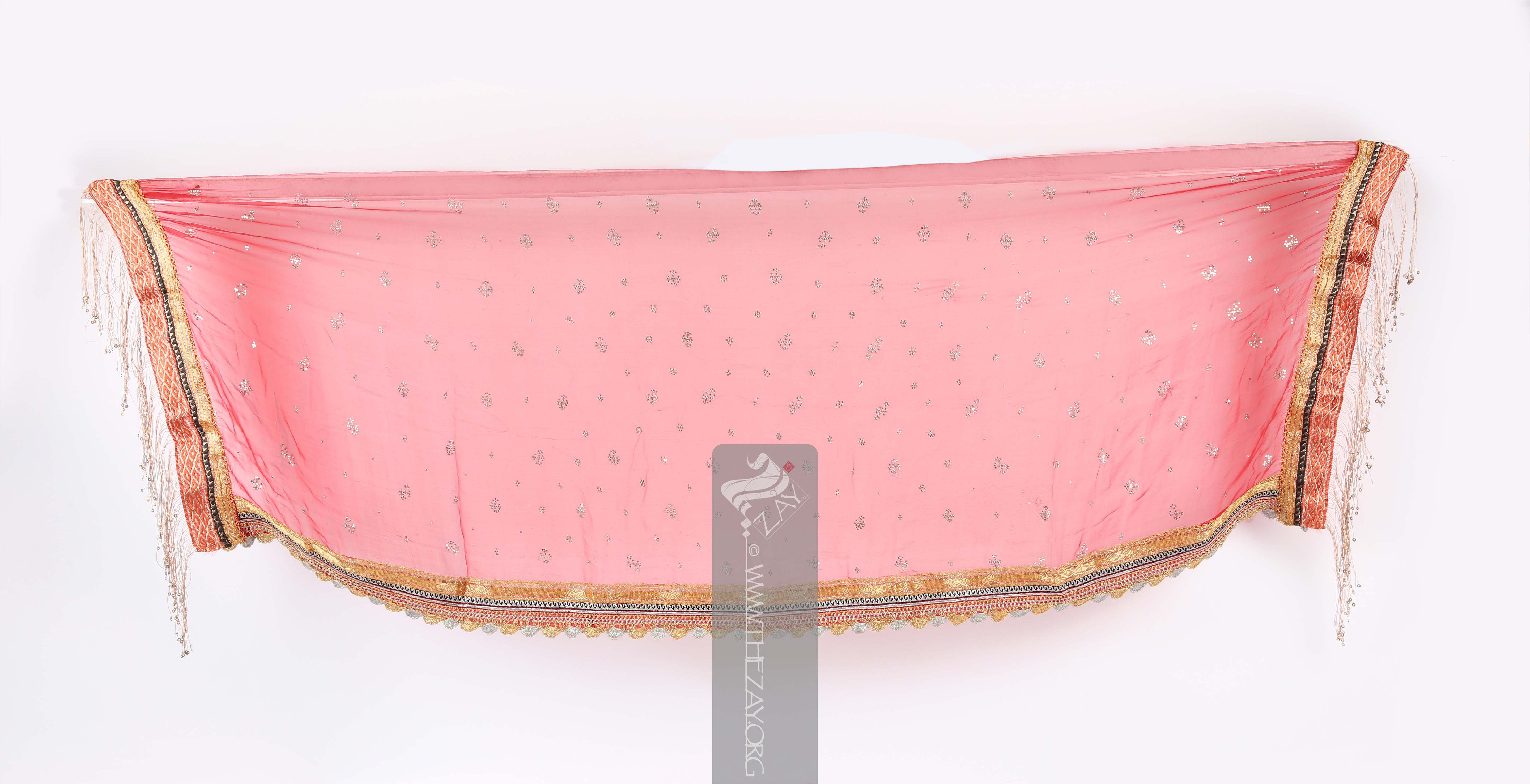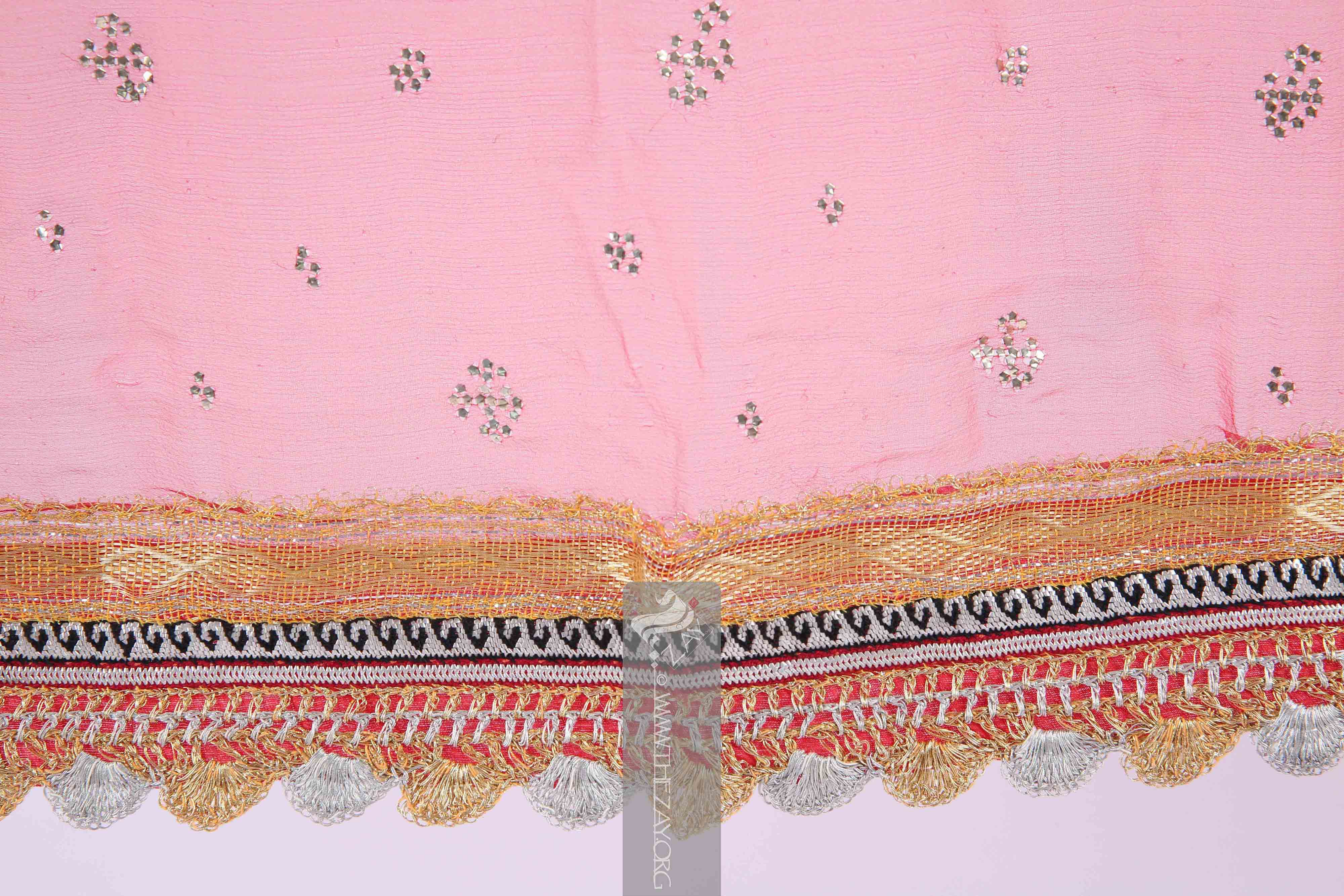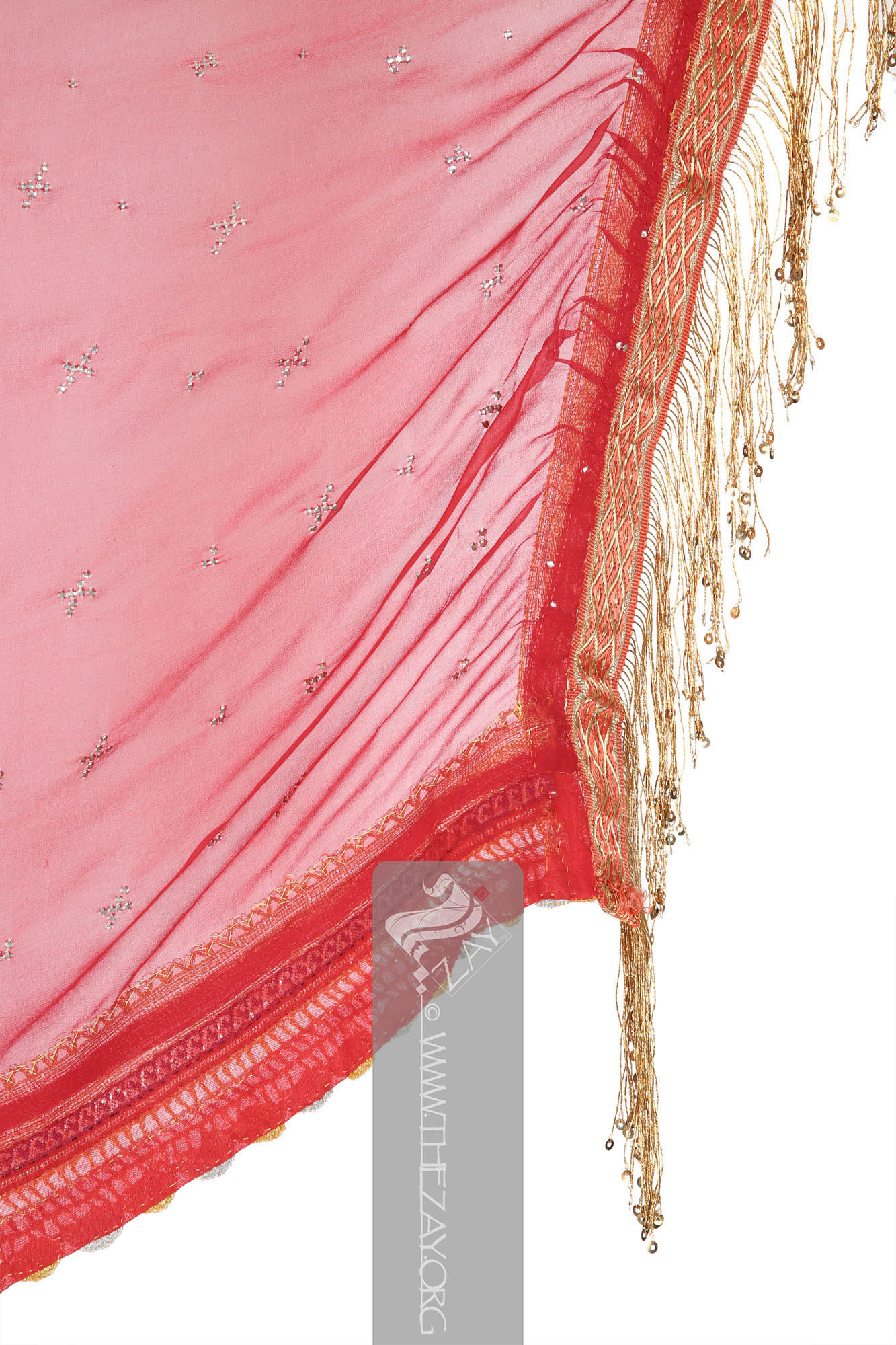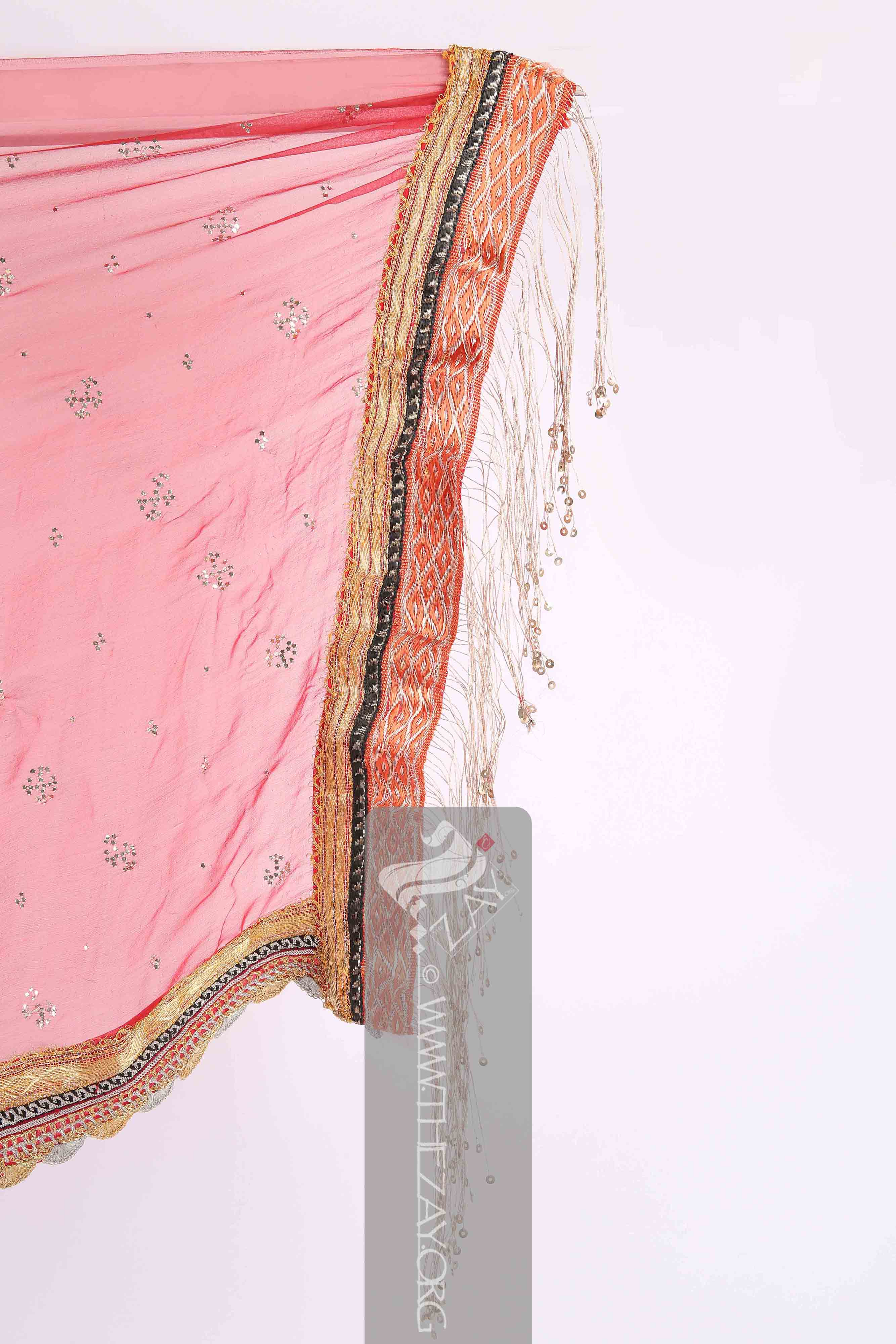Object NotePart of an ensemble consisting of two more parts (
ZI2018 500.121 ASIA and
ZI2018 500121b ASIA).
Object History This object was sourced with the help of fashion designer Homeira Ebadi from an elderly lady, Bebe Asad Allah Deen / Bebe Asad Alauddin of Fishvar village in the Larestan county of Fars province, Iran. It was purchased by her on behalf of
Dr. Reem Tariq
Ṭariq: (Arabic; Synonym: tulle_bi_talli
Tūlle_bi_tallī: (French: Tulle – a city in France where fine material for veil was first made; Turkish: tel – wire; Synonym: tariq; talli; badla; khus_dozi ), series of small metal knots made on a woven net ground as embellishment. The term is commonly used in the North African Arab region specifically in Egypt.
; talli; badla; khus_dozi ), series of small metal knots made on a woven net ground as embellishment. The term is commonly used in the Levant Arab region specifically in Lebanon.
El Mutwalli
Dr. Reem Tariq
Ṭariq: (Arabic; Synonym: tulle_bi_talli
Tūlle_bi_tallī: (French: Tulle – a city in France where fine material for veil was first made; Turkish: tel – wire; Synonym: tariq; talli; badla; khus_dozi ), series of small metal knots made on a woven net ground as embellishment. The term is commonly used in the North African Arab region specifically in Egypt.
; talli; badla; khus_dozi ), series of small metal knots made on a woven net ground as embellishment. The term is commonly used in the Levant Arab region specifically in Lebanon.
el Mutwallī: Founder (CEO) of the Zay
Zay: (Arabic: costume, Pl. azyaā’), a set of clothes in a style typical of a particular country or historical period. Initiative, a public figure, speaker and author. An expert curator and consultant in Islamic art and architecture, interior design, historic costume, and UAE heritage. in 2018 to be added to The
Zay
Zay: (Arabic: costume, Pl. azyaā’), a set of clothes in a style typical of a particular country or historical period. initiative collection.
Apart from being a fashion designer Ms. Ebadi is a dedicated volunteer associated with The
Zay
Zay: (Arabic: costume, Pl. azyaā’), a set of clothes in a style typical of a particular country or historical period. Initiative and its cause, often lending a hand in sourcing unique pieces like this. Our heartfelt gratitude to Ms. Ebadi for her efforts for her contribution.
Object Features This head
scarf
Scarf: (English), usually a rectangular piece of cloth loosely worn over the shoulders, upper body and arms, and sometimes also over the head. or veil (
meyna
Meynā: (Synonym: rusari
Rūsarī: (Synonym: meyna, Qashqai – lačak), a pan Iranian term for headscarves or veils worn by women in Iran. It is also used sometimes to loosely refer a chador or hijab too. , Qashqai – lačak, čarqad), a kind of head scarf
Scarf: (English), usually a rectangular piece of cloth loosely worn over the shoulders, upper body and arms, and sometimes also over the head. or veil worn by Bakhtiari and Boir-Ahmadi women of the Lori speaking ethnicity in Iran. It is draped over the head and pinned under the chin without covering their faces. ) is made of red silk
gauze
Gauze: (English), very fine wire mesh transparent fabric of silk, linen, or cotton. or chiffon with metal embroidery commonly known as (
badlah
Bādlah: (Hindustani: badal – cloud from Sanskirt: vārdala – water; Synonym: tariq; talli
Tallī: (Turkish: tel – wire, string), Gulf Arab – a woven braided trimming made with metal wire, threads and ribbons often sewn on detachable panels used as embellishments. Other – (Synonym: tulle_bi_talli
Tūlle_bi_tallī: (French: Tulle – a city in France where fine material for veil was first made; Turkish: tel – wire; Synonym: tariq; talli; badla; khus_dozi ), series of small metal knots made on a woven net ground as embellishment. The term is commonly used in the North African Arab region specifically in Egypt.
; tariq; badla; khus_dozi), series of small metal knots made on a woven net ground as embellishment.
; tulle_bi_talli
Tūlle_bi_tallī: (French: Tulle – a city in France where fine material for veil was first made; Turkish: tel – wire; Synonym: tariq; talli; badla; khus_dozi ), series of small metal knots made on a woven net ground as embellishment. The term is commonly used in the North African Arab region specifically in Egypt.
; khus_dozi
Khus_dozi: (Persian: Khvosh – an Iranian province; dozi – needlework; Synonym: tariq; talli
Tallī: (Turkish: tel – wire, string), Gulf Arab – a woven braided trimming made with metal wire, threads and ribbons often sewn on detachable panels used as embellishments. Other – (Synonym: tulle_bi_talli
Tūlle_bi_tallī: (French: Tulle – a city in France where fine material for veil was first made; Turkish: tel – wire; Synonym: tariq; talli; badla; khus_dozi ), series of small metal knots made on a woven net ground as embellishment. The term is commonly used in the North African Arab region specifically in Egypt.
; tariq; badla; khus_dozi), series of small metal knots made on a woven net ground as embellishment.
; tulle_bi_talli
Tūlle_bi_tallī: (French: Tulle – a city in France where fine material for veil was first made; Turkish: tel – wire; Synonym: tariq; talli; badla; khus_dozi ), series of small metal knots made on a woven net ground as embellishment. The term is commonly used in the North African Arab region specifically in Egypt.
; badla), series of small metal knots made on a woven net ground as embellishment. The term is commonly used in Iran and parts of the Arabian Peninsula possibly because Khvosh was one of the centres for the craft.
), series of small metal knots made on a woven net ground as embellishment. The term is commonly used in India and parts of the subcontinent.
) throughout Iran as well as South Asia – India, Pakistan, and Bangladesh. Although a rectangular piece it has two rounded corners for the purpose of easy draping around the head and shoulders.
Three sides of the veil are finished with metal thread (
zari
Zarī: (Persian two-syllables: zar: gold & dozi: embellishment), complex embroidery technique that uses metal alloy on silk, satin, or velvet, and may include pearls, beads, and precious stones. Colloquially in the Arab gulf region, the term (zarī) is loosely applied to any gilded thread, embellishment or gilded brocade fabric. Originated in ancient Persia it has been used extensively in Indian and Middle Eastern textiles for centuries. ) – possibly gold and silver – crocheted trimmings in five different layers on the horizontal side. The outermost layer around the edge is adorned with gold and silver scallops sewn into the edge.
This is followed by an interlaced square pattern which is further followed by two strips of
badlah
Bādlah: (Hindustani: badal – cloud from Sanskirt: vārdala – water; Synonym: tariq; talli
Tallī: (Turkish: tel – wire, string), Gulf Arab – a woven braided trimming made with metal wire, threads and ribbons often sewn on detachable panels used as embellishments. Other – (Synonym: tulle_bi_talli
Tūlle_bi_tallī: (French: Tulle – a city in France where fine material for veil was first made; Turkish: tel – wire; Synonym: tariq; talli; badla; khus_dozi ), series of small metal knots made on a woven net ground as embellishment. The term is commonly used in the North African Arab region specifically in Egypt.
; tariq; badla; khus_dozi), series of small metal knots made on a woven net ground as embellishment.
; tulle_bi_talli
Tūlle_bi_tallī: (French: Tulle – a city in France where fine material for veil was first made; Turkish: tel – wire; Synonym: tariq; talli; badla; khus_dozi ), series of small metal knots made on a woven net ground as embellishment. The term is commonly used in the North African Arab region specifically in Egypt.
; khus_dozi
Khus_dozi: (Persian: Khvosh – an Iranian province; dozi – needlework; Synonym: tariq; talli
Tallī: (Turkish: tel – wire, string), Gulf Arab – a woven braided trimming made with metal wire, threads and ribbons often sewn on detachable panels used as embellishments. Other – (Synonym: tulle_bi_talli
Tūlle_bi_tallī: (French: Tulle – a city in France where fine material for veil was first made; Turkish: tel – wire; Synonym: tariq; talli; badla; khus_dozi ), series of small metal knots made on a woven net ground as embellishment. The term is commonly used in the North African Arab region specifically in Egypt.
; tariq; badla; khus_dozi), series of small metal knots made on a woven net ground as embellishment.
; tulle_bi_talli
Tūlle_bi_tallī: (French: Tulle – a city in France where fine material for veil was first made; Turkish: tel – wire; Synonym: tariq; talli; badla; khus_dozi ), series of small metal knots made on a woven net ground as embellishment. The term is commonly used in the North African Arab region specifically in Egypt.
; badla), series of small metal knots made on a woven net ground as embellishment. The term is commonly used in Iran and parts of the Arabian Peninsula possibly because Khvosh was one of the centres for the craft.
), series of small metal knots made on a woven net ground as embellishment. The term is commonly used in India and parts of the subcontinent.
in different widths featuring geometric patterns. This edging is topped with a gold and silver
zari
Zarī: (Persian two-syllables: zar: gold & dozi: embellishment), complex embroidery technique that uses metal alloy on silk, satin, or velvet, and may include pearls, beads, and precious stones. Colloquially in the Arab gulf region, the term (zarī) is loosely applied to any gilded thread, embellishment or gilded brocade fabric. Originated in ancient Persia it has been used extensively in Indian and Middle Eastern textiles for centuries. woven lace trimming. The narrower ends of the veil have four layers of border. Starting with the lace trimming at the inner end, which is followed by a black and gold woven strip which is further followed by a wide strip woven in rose gold threads and orange silk
floss
Floss: (Old French: flosche – nap of velvet), is a type of silk fibre obtained from the cocoons of wild silkworms. It is characterized by its long, fluffy fibers that are not tightly woven, making it ideal for use in various textile applications such as embroidery, lace-making, and sewing. creating a repeat of diamond patterns. The final layer is the series of threads hanging loose from the edge in a fringe with golden sequins attached to it at the end.
Although (
rusari
Rūsarī: (Synonym: meyna, Qashqai – lačak), a pan Iranian term for headscarves or veils worn by women in Iran. It is also used sometimes to loosely refer a chador or hijab too. ) is the pan-Iranian term for veils, diaphanous
meyna
Meynā: (Synonym: rusari
Rūsarī: (Synonym: meyna, Qashqai – lačak), a pan Iranian term for headscarves or veils worn by women in Iran. It is also used sometimes to loosely refer a chador or hijab too. , Qashqai – lačak, čarqad), a kind of head scarf
Scarf: (English), usually a rectangular piece of cloth loosely worn over the shoulders, upper body and arms, and sometimes also over the head. or veil worn by Bakhtiari and Boir-Ahmadi women of the Lori speaking ethnicity in Iran. It is draped over the head and pinned under the chin without covering their faces. like this are commonly worn with a collarless ceremonial shirt of silk
brocade
Brocade: (Italian: brocco – twisted thread), is a richly decorative fabric woven with an intricate raised pattern. Its origins can be traced back to ancient China, where it was made for the imperial court. It later spread to Europe during the Renaissance and became popular in couture and decorative arts. (
jama_atlas
Jama_atlas: (Hindustani: jama – A robe; Atlas – silk obtained from the Atlas worm; Synonym: Juma_atlas
Juma_atlas: (Hindustani: Juma – A robe; Atlas – silk obtained from the Atlas worm; Synonym: Jama_atlas), a collarless shirt of silk brocade fabric worn during ceremonial occasions like weddings by women of the Lori speaking ethnic community in south and southwest of Iran. ), a collarless shirt of silk brocade fabric worn during ceremonial occasions like weddings by women of the Lori speaking ethnic community in south and southwest of Iran. /
juma_atlas
Juma_atlas: (Hindustani: Juma – A robe; Atlas – silk obtained from the Atlas worm; Synonym: Jama_atlas), a collarless shirt of silk brocade fabric worn during ceremonial occasions like weddings by women of the Lori speaking ethnic community in south and southwest of Iran. ) or a long-sleeved tunic (pirhan) or the Qashqai (
keynak
Keynak: (Turkmen: Koynek
Koynek: A traditional long, loose-fitting tunic or dress worn by Turkmen women in Central Asia typically made of silk or cotton, adorned with intricate embroidery, and often characterized by vibrant colours and geometric patterns. It is cultural symbol of significant importance reflecting the artistic heritage of Turkmen people. – Women’s loose ankle length tunic), a traditional collarless shirt for men and tunic dress for women of the Turkic speaking Qashqai tribe in Iran. ) and a full or divided skirt (
tombun_zanuna
Tombūn-zanūna: (Persian: zanu/zanoo – knee; Synonym: Tonban
Tonbān: (Persian, Synonym: tombun_zanuna, Salita), traditional long skirts usually of satin silk worn by Turkic speaking Qashqai women of Iran. , Salita), traditional long skirts usually of satin silk worn by Lori speaking ethnic women of Iran. ) and a pair of underdrawers (
zirsawlar
) by women of the Lori speaking ethnicity.
While the Lori community calls it the
meyna
Meynā: (Synonym: rusari
Rūsarī: (Synonym: meyna, Qashqai – lačak), a pan Iranian term for headscarves or veils worn by women in Iran. It is also used sometimes to loosely refer a chador or hijab too. , Qashqai – lačak, čarqad), a kind of head scarf
Scarf: (English), usually a rectangular piece of cloth loosely worn over the shoulders, upper body and arms, and sometimes also over the head. or veil worn by Bakhtiari and Boir-Ahmadi women of the Lori speaking ethnicity in Iran. It is draped over the head and pinned under the chin without covering their faces. and is usually paired with a hood (
lačak
) underneath it, the women of the Qashqai tribes – Turkic origin from the Zagros mountainous region – whose traditional dresses until c. the 1920s were heavily influenced and were almost similar to the population of southwest Iran – Fars, Kohgiluyeh and Boyer-Ahmad, west Hormozgan, etc. –referred to their diaphanous veil as
lačak
or (čarqad) which they draped over a small skull cap called (
kolaqča
).
Although this ensemble has a very close resemblance to the regular ensemble from Fishvar – also in Fars province, Iran rife with Lori-speaking tribes –it is worth noting that this ensemble is a ceremonial garment for occasional wear. While the northern Lori women would be seen wearing a
scarf
Scarf: (English), usually a rectangular piece of cloth loosely worn over the shoulders, upper body and arms, and sometimes also over the head. (
tara_awwal
Tarā_awwal: (Arabic: awwal – first); a scarf traditionally worn by the Lori speaking ethnic women before wrapping their traditional turban – tara. ) and a turban (
tara
Tarā: A kind of turban traditionally worn by Lori speaking ethnic women over their scarves. ) over it on their heads, the Bakhtiari and Boir-Ahmadi women of the south often drape their heads with a hood (
lačak
) and fine veil (
meyna
Meynā: (Synonym: rusari
Rūsarī: (Synonym: meyna, Qashqai – lačak), a pan Iranian term for headscarves or veils worn by women in Iran. It is also used sometimes to loosely refer a chador or hijab too. , Qashqai – lačak, čarqad), a kind of head scarf
Scarf: (English), usually a rectangular piece of cloth loosely worn over the shoulders, upper body and arms, and sometimes also over the head. or veil worn by Bakhtiari and Boir-Ahmadi women of the Lori speaking ethnicity in Iran. It is draped over the head and pinned under the chin without covering their faces. ) over it.
It is worth noting that the name
badlah
Bādlah: (Hindustani: badal – cloud from Sanskirt: vārdala – water; Synonym: tariq; talli
Tallī: (Turkish: tel – wire, string), Gulf Arab – a woven braided trimming made with metal wire, threads and ribbons often sewn on detachable panels used as embellishments. Other – (Synonym: tulle_bi_talli
Tūlle_bi_tallī: (French: Tulle – a city in France where fine material for veil was first made; Turkish: tel – wire; Synonym: tariq; talli; badla; khus_dozi ), series of small metal knots made on a woven net ground as embellishment. The term is commonly used in the North African Arab region specifically in Egypt.
; tariq; badla; khus_dozi), series of small metal knots made on a woven net ground as embellishment.
; tulle_bi_talli
Tūlle_bi_tallī: (French: Tulle – a city in France where fine material for veil was first made; Turkish: tel – wire; Synonym: tariq; talli; badla; khus_dozi ), series of small metal knots made on a woven net ground as embellishment. The term is commonly used in the North African Arab region specifically in Egypt.
; khus_dozi
Khus_dozi: (Persian: Khvosh – an Iranian province; dozi – needlework; Synonym: tariq; talli
Tallī: (Turkish: tel – wire, string), Gulf Arab – a woven braided trimming made with metal wire, threads and ribbons often sewn on detachable panels used as embellishments. Other – (Synonym: tulle_bi_talli
Tūlle_bi_tallī: (French: Tulle – a city in France where fine material for veil was first made; Turkish: tel – wire; Synonym: tariq; talli; badla; khus_dozi ), series of small metal knots made on a woven net ground as embellishment. The term is commonly used in the North African Arab region specifically in Egypt.
; tariq; badla; khus_dozi), series of small metal knots made on a woven net ground as embellishment.
; tulle_bi_talli
Tūlle_bi_tallī: (French: Tulle – a city in France where fine material for veil was first made; Turkish: tel – wire; Synonym: tariq; talli; badla; khus_dozi ), series of small metal knots made on a woven net ground as embellishment. The term is commonly used in the North African Arab region specifically in Egypt.
; badla), series of small metal knots made on a woven net ground as embellishment. The term is commonly used in Iran and parts of the Arabian Peninsula possibly because Khvosh was one of the centres for the craft.
), series of small metal knots made on a woven net ground as embellishment. The term is commonly used in India and parts of the subcontinent.
for this type of embroidery is although the same across Iran and South Asia it is also sometimes commonly referred to as (
khus_dozi
Khus_dozi: (Persian: Khvosh – an Iranian province; dozi – needlework; Synonym: tariq; talli
Tallī: (Turkish: tel – wire, string), Gulf Arab – a woven braided trimming made with metal wire, threads and ribbons often sewn on detachable panels used as embellishments. Other – (Synonym: tulle_bi_talli
Tūlle_bi_tallī: (French: Tulle – a city in France where fine material for veil was first made; Turkish: tel – wire; Synonym: tariq; talli; badla; khus_dozi ), series of small metal knots made on a woven net ground as embellishment. The term is commonly used in the North African Arab region specifically in Egypt.
; tariq; badla; khus_dozi), series of small metal knots made on a woven net ground as embellishment.
; tulle_bi_talli
Tūlle_bi_tallī: (French: Tulle – a city in France where fine material for veil was first made; Turkish: tel – wire; Synonym: tariq; talli; badla; khus_dozi ), series of small metal knots made on a woven net ground as embellishment. The term is commonly used in the North African Arab region specifically in Egypt.
; badla), series of small metal knots made on a woven net ground as embellishment. The term is commonly used in Iran and parts of the Arabian Peninsula possibly because Khvosh was one of the centres for the craft.
) in south Iran.
It is believed that the term
badlah
Bādlah: (Hindustani: badal – cloud from Sanskirt: vārdala – water; Synonym: tariq; talli
Tallī: (Turkish: tel – wire, string), Gulf Arab – a woven braided trimming made with metal wire, threads and ribbons often sewn on detachable panels used as embellishments. Other – (Synonym: tulle_bi_talli
Tūlle_bi_tallī: (French: Tulle – a city in France where fine material for veil was first made; Turkish: tel – wire; Synonym: tariq; talli; badla; khus_dozi ), series of small metal knots made on a woven net ground as embellishment. The term is commonly used in the North African Arab region specifically in Egypt.
; tariq; badla; khus_dozi), series of small metal knots made on a woven net ground as embellishment.
; tulle_bi_talli
Tūlle_bi_tallī: (French: Tulle – a city in France where fine material for veil was first made; Turkish: tel – wire; Synonym: tariq; talli; badla; khus_dozi ), series of small metal knots made on a woven net ground as embellishment. The term is commonly used in the North African Arab region specifically in Egypt.
; khus_dozi
Khus_dozi: (Persian: Khvosh – an Iranian province; dozi – needlework; Synonym: tariq; talli
Tallī: (Turkish: tel – wire, string), Gulf Arab – a woven braided trimming made with metal wire, threads and ribbons often sewn on detachable panels used as embellishments. Other – (Synonym: tulle_bi_talli
Tūlle_bi_tallī: (French: Tulle – a city in France where fine material for veil was first made; Turkish: tel – wire; Synonym: tariq; talli; badla; khus_dozi ), series of small metal knots made on a woven net ground as embellishment. The term is commonly used in the North African Arab region specifically in Egypt.
; tariq; badla; khus_dozi), series of small metal knots made on a woven net ground as embellishment.
; tulle_bi_talli
Tūlle_bi_tallī: (French: Tulle – a city in France where fine material for veil was first made; Turkish: tel – wire; Synonym: tariq; talli; badla; khus_dozi ), series of small metal knots made on a woven net ground as embellishment. The term is commonly used in the North African Arab region specifically in Egypt.
; badla), series of small metal knots made on a woven net ground as embellishment. The term is commonly used in Iran and parts of the Arabian Peninsula possibly because Khvosh was one of the centres for the craft.
), series of small metal knots made on a woven net ground as embellishment. The term is commonly used in India and parts of the subcontinent.
is derived from the phrase ‘badal kinari’ – cloud lining – popular during the Mughal period in India as net or fine
gauze
Gauze: (English), very fine wire mesh transparent fabric of silk, linen, or cotton. silk were often embroidered with metal pieces giving them the look of clouds with bright lines around them.
However, upon crossing the Gulf and reaching the Arabian Peninsula the nomenclature of the embroidery changes to (
talli
Tallī: (Turkish: tel – wire, string), Gulf Arab – a woven braided trimming made with metal wire, threads and ribbons often sewn on detachable panels used as embellishments. Other – (Synonym: tulle_bi_talli
Tūlle_bi_tallī: (French: Tulle – a city in France where fine material for veil was first made; Turkish: tel – wire; Synonym: tariq; talli; badla; khus_dozi ), series of small metal knots made on a woven net ground as embellishment. The term is commonly used in the North African Arab region specifically in Egypt.
; tariq; badla; khus_dozi), series of small metal knots made on a woven net ground as embellishment.
/
tulle_bi_talli
Tūlle_bi_tallī: (French: Tulle – a city in France where fine material for veil was first made; Turkish: tel – wire; Synonym: tariq; talli; badla; khus_dozi ), series of small metal knots made on a woven net ground as embellishment. The term is commonly used in the North African Arab region specifically in Egypt.
), while the cuffs of women’s trousers which are detachable and could be changed are called
badlah
Bādlah: (Hindustani: badal – cloud from Sanskirt: vārdala – water; Synonym: tariq; talli
Tallī: (Turkish: tel – wire, string), Gulf Arab – a woven braided trimming made with metal wire, threads and ribbons often sewn on detachable panels used as embellishments. Other – (Synonym: tulle_bi_talli
Tūlle_bi_tallī: (French: Tulle – a city in France where fine material for veil was first made; Turkish: tel – wire; Synonym: tariq; talli; badla; khus_dozi ), series of small metal knots made on a woven net ground as embellishment. The term is commonly used in the North African Arab region specifically in Egypt.
; tariq; badla; khus_dozi), series of small metal knots made on a woven net ground as embellishment.
; tulle_bi_talli
Tūlle_bi_tallī: (French: Tulle – a city in France where fine material for veil was first made; Turkish: tel – wire; Synonym: tariq; talli; badla; khus_dozi ), series of small metal knots made on a woven net ground as embellishment. The term is commonly used in the North African Arab region specifically in Egypt.
; khus_dozi
Khus_dozi: (Persian: Khvosh – an Iranian province; dozi – needlework; Synonym: tariq; talli
Tallī: (Turkish: tel – wire, string), Gulf Arab – a woven braided trimming made with metal wire, threads and ribbons often sewn on detachable panels used as embellishments. Other – (Synonym: tulle_bi_talli
Tūlle_bi_tallī: (French: Tulle – a city in France where fine material for veil was first made; Turkish: tel – wire; Synonym: tariq; talli; badla; khus_dozi ), series of small metal knots made on a woven net ground as embellishment. The term is commonly used in the North African Arab region specifically in Egypt.
; tariq; badla; khus_dozi), series of small metal knots made on a woven net ground as embellishment.
; tulle_bi_talli
Tūlle_bi_tallī: (French: Tulle – a city in France where fine material for veil was first made; Turkish: tel – wire; Synonym: tariq; talli; badla; khus_dozi ), series of small metal knots made on a woven net ground as embellishment. The term is commonly used in the North African Arab region specifically in Egypt.
; badla), series of small metal knots made on a woven net ground as embellishment. The term is commonly used in Iran and parts of the Arabian Peninsula possibly because Khvosh was one of the centres for the craft.
), series of small metal knots made on a woven net ground as embellishment. The term is commonly used in India and parts of the subcontinent.
.
With cross-cultural lineages running deep between the communities living on either side of the Gulf, it is thus no wonder, that material culture such as this has found firm grounds on both sides.
Although part of an ensemble in the collection, the sourcing of each item in the series has been done separately. However, traditional women’s costumes from the Fars province of Iran consisted of similar pieces put together.
Links 



